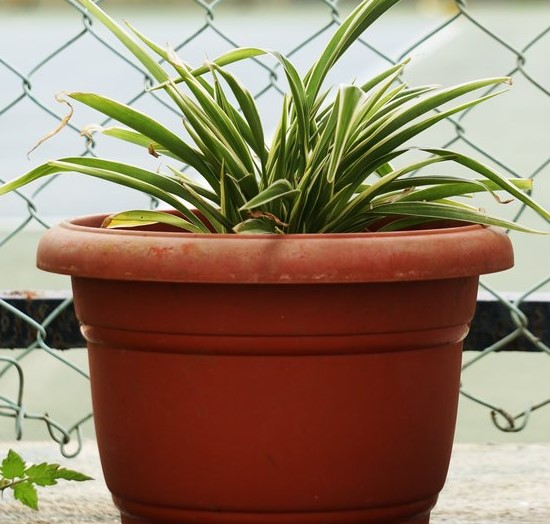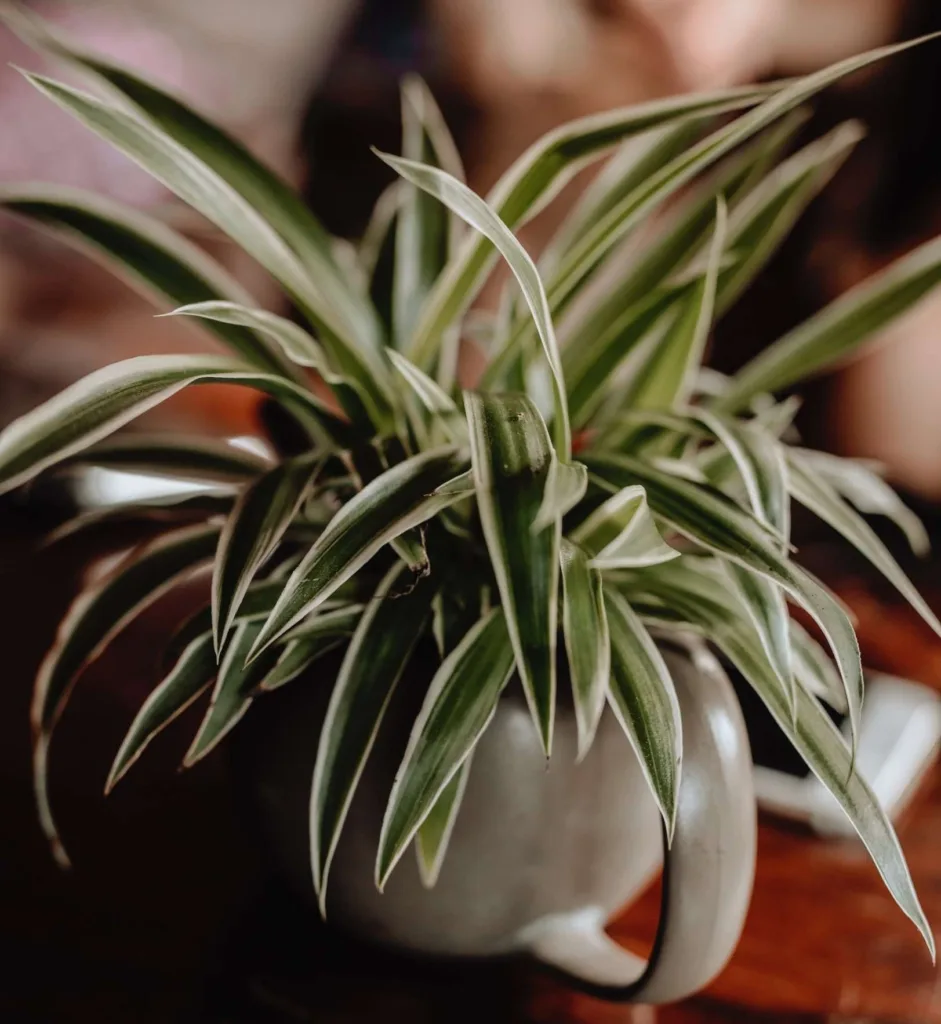Spider plants, known scientifically as Chlorophytum comosum, are popular houseplants that are loved for their graceful arching leaves and charming spider-like babies that dangle from long, wiry stems.
Before we delve into the nitty-gritty of spider plant care, it’s essential to have a basic understanding of this delightful plant.
Originating from South Africa, spider plants belong to the family Asparagaceae and are characterized by their elongated, arching leaves that display vibrant green stripes.
These plants are not just eye-catching additions to your home decor but also have the added benefit of purifying the air by removing toxins, such as formaldehyde and xylene.
These plants are not only visually appealing but also incredibly easy to care for, making them the perfect choice for beginners and seasoned plant enthusiasts alike.
| Aspect | Description |
|---|---|
| Scientific Name | Chlorophytum comosum |
| Common Names | Spider Plant, Airplane Plant, Spider Ivy |
| Appearance | Long, arching leaves with green and white stripes |
| Special Feature | Production of spiderettes (offshoots with baby plantlets) |
| Hardiness | Hardy and adaptable to various indoor conditions |
| Light Requirements | Prefers bright, indirect light; tolerates lower light levels |
| Watering Needs | Keep soil consistently moist; avoid overwatering |
| Temperature Tolerance | Thrives in normal room temperatures |
| Toxicity | Generally non-toxic to humans and pets, but some sensitivity in cats; safe when ingested in small quantities |
| Air-Purifying Qualities | Effective in removing pollutants like formaldehyde and VOCs |
| Propagation Method | Easily propagated by dividing the plant or potting spiderettes |
| Ease of Care | Considered easy to care for, suitable for beginners |
Grow and Care Spider Plant the Right Environment
Spider plants thrive in moderate to bright indirect light, making them the perfect companion for both sunlit rooms and areas with limited natural light.
However, it’s essential to strike a balance and avoid exposing them to direct sunlight for extended periods, as their delicate leaves may scorch.
As for temperature, spider plants are adaptable and can tolerate a wide range, but they prefer temperatures between 60°F to 75°F (15°C to 24°C).
Similarly, these plants can tolerate different humidity levels, but it’s best to aim for a moderate humidity range of 40% to 60%.
Selecting the Ideal Pot and Potting Mix
When it comes to choosing the right pot for your spider plant, opt for a container with drainage holes to prevent overwatering and root rot.
Spider plants prefer to be slightly root-bound, so choose a pot that is just a few inches larger in diameter than the existing root system. As for the potting mix, a well-draining soil that retains some moisture is the key.
A combination of peat moss, perlite, and coco coir works well to create a loose and well-aerated medium for the spider plant’s roots to grow and flourish.
Watering Spider Plants
When it comes to watering your spider plant, finding the right balance is crucial. Overwatering can lead to root rot, while underwatering can cause the leaves to wither and turn brown. Spider plants prefer moist soil but not soggy conditions.
As a general rule, water your plant when the top inch (2.5 cm) of soil feels dry to the touch. Ensure that excess water drains out from the bottom of the pot to prevent waterlogged roots.
During the growing season (spring and summer), watering once or twice a week is usually sufficient, while in the dormant phase (winter), watering once every two weeks is typically enough.
Humidity and Spider Plants
While spider plants can tolerate varying humidity levels, they do appreciate higher humidity. In dryer environments, you can increase humidity by using a humidifier or placing a tray of water near your plant.
Grouping multiple plants together can also create a microclimate with increased humidity. Misting your spider plant’s leaves occasionally is another simple yet effective way to boost moisture levels and keep your plant happy and healthy.
Fertilizing Spider Plants
Fertilizing your spider plant is essential to ensure optimal growth and keep those vibrant green leaves looking their best.
During the active growing season (spring and summer), feed your plant with a balanced houseplant fertilizer every two to three weeks. Dilute the fertilizer to half the recommended strength to avoid overfeeding.
In the dormant season, you can reduce the frequency of fertilizing to once a month. Always remember to water your plant thoroughly before applying any fertilizer to prevent root burn.

Propagating Spider Plants
One of the most charming aspects of spider plants is their ability to produce numerous spiderettes, or plantlets, that can be easily propagated.
To propagate your spider plant, simply locate the small spiderettes that emerge from the mother plant’s long stems. Once the spiderettes have developed roots of their own, carefully cut or separate them from the parent plant and plant them in a separate pot with a moist potting mix.
Spiderettes can also be left attached to the mother plant until they develop a more substantial root system before propagation.
| Spider plants are indoor plants that do a great job of cleaning the air in our homes. They release oxygen, studies conducted by NASA have shown that spider plants can help remove pollutants like formaldehyde, xylene, toluene, and ammonia from indoor air. These plants are easy to care for, adapt to different light conditions, and can even produce more plants on their own. Hence, having spider plants around not only adds a touch of greenery but also contributes to making the air we breathe indoors healthy. |
Common Pests and Problems
While spider plants are generally hardy and resistant to pests, a few common nuisances may occasionally appear.
Spider mites and aphids can infest spider plants, resulting in webbing or tiny insects on the leaves. Gently wiping the leaves with a damp cloth and using insecticidal soap can help eliminate these pests.
Additionally, brown tips on the leaves may indicate underwatering or low humidity, while yellowing leaves can be a sign of overwatering or nutrient deficiencies. By adjusting your watering routine and providing the necessary environmental conditions, you can easily overcome these challenges.
Spider Plant Variety
There are several varieties and cultivars of spider plants (Chlorophytum comosum), each with its own unique characteristics. Here are some common spider plant varieties:
- Chlorophytum comosum ‘Vittatum’:
- This is the classic spider plant with arching leaves that are green with white stripes. It’s one of the most popular varieties and is often seen in homes and offices.
- Chlorophytum comosum ‘Variegatum’:
- Similar to ‘Vittatum,’ this variety has green leaves with creamy-white stripes. It’s known for its attractive variegation.
- Chlorophytum comosum ‘Bonnie:’
- ‘Bonnie’ is a compact variety of spider plant with shorter leaves than the traditional type. It’s well-suited for smaller spaces.
- Chlorophytum comosum ‘Mandaianum’:
- This variety has a more upright growth habit compared to the arching leaves of other spider plants. It’s known for its dense foliage.
- Chlorophytum comosum ‘Ocean:’
- ‘Ocean’ is a variegated spider plant with green leaves and white stripes. It’s characterized by its cascading growth, making it suitable for hanging baskets.
- Chlorophytum comosum ‘Zebra Grass’:
- This variety has broader leaves with a central green stripe and white margins, resembling a zebra pattern.
- Chlorophytum comosum ‘Hawaiian:’
- ‘Hawaiian’ is known for its rich green leaves with white stripes. It’s a hardy and adaptable variety.
- Chlorophytum comosum ‘Milky Way’:
- ‘Milky Way’ is a compact and bushy variety with numerous arching leaves. It features white stripes on green leaves.
Can Spider Plants Grow in Water
Yes, spider plants (Chlorophytum comosum) can be propagated and grown in water. Here’s a simple guide on how to do it:
- Select a Healthy Spiderette:
- Choose a healthy spiderette, which is a small offshoot or baby plant that forms on the long stems of mature spider plants.
- Cut the Spiderette:
- Using clean scissors or pruning shears, carefully cut the spiderette from the main plant. Ensure that the spiderette has a good length of stem attached.
- Place in Water:
- Fill a glass or jar with water, and submerge the base of the spiderette in the water. The stem should be immersed, and the spiderette should be supported above the water.
- Change the Water:
- Change the water regularly, ideally every few days, to prevent stagnation and the growth of algae. Use room-temperature water.
- Wait for Roots to Develop:
- Over time, the spiderette will start developing roots. This process can take a few weeks. Once the roots are a couple of inches long, the spiderette is ready for planting.
- Plant in Soil:
- Transfer the spiderette with its developed roots to a pot with well-draining potting soil. Plant it at a depth that covers the roots, and water the soil thoroughly.
- Provide Care:
- Place the newly planted spiderette in a location with bright, indirect light. Water it when the top inch of soil feels dry, and maintain a regular care routine.
Growing spider plants in water is an effective way to propagate new plants. Once the spiderette has developed enough roots, it can be transferred to soil for long-term growth. This method allows you to expand your collection of spider plants and share them with others.
Conclusion
Congratulations! You are now equipped with all the knowledge you need to successfully grow and care for your very own spider plants.
From choosing the ideal potting mix and providing the right lighting conditions to watering and fertilizing, these low-maintenance plants are sure to thrive in your home.
Remember to keep an eye out for spiderettes and propagate them to expand your spider plant family. With their elegant cascading leaves and air-purifying qualities, spider plants are not only beautiful but also a joy to nurture.
So, go ahead and welcome these charming green companions into your home, and enjoy the rewards of caring for them!
People Also Ask
- Is a spider plant good for your house?
- Yes, spider plants are good for your house. They are known for their air-purifying qualities, releasing oxygen and helping to remove certain indoor pollutants.
- What are the disadvantages of spider plants?
- While generally considered safe, some cats may be attracted to chewing on spider plant leaves, which, in large quantities, can cause mild digestive upset. Additionally, overwatering can lead to root rot, so it’s essential not to let the soil become waterlogged.
- Do spider plants like direct sunlight?
- Spider plants prefer bright, indirect light. While they can tolerate some direct sunlight, prolonged exposure may lead to leaf scorching. They thrive in well-lit but shaded conditions.
- Are spider plants easy to keep alive?
- Yes, spider plants are known for their resilience and are considered easy to keep alive. They can adapt to a variety of indoor conditions, making them suitable for both novice and experienced plant enthusiasts. Regular watering, moderate light, and occasional fertilizing contribute to their well-being.

